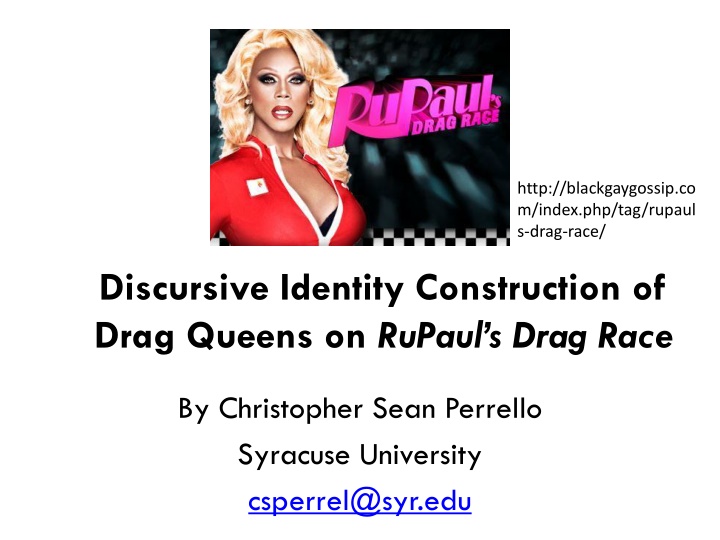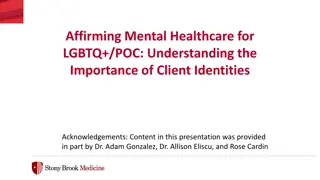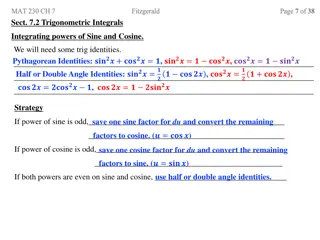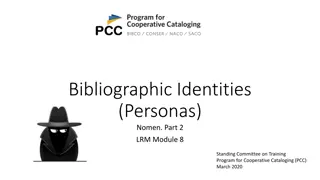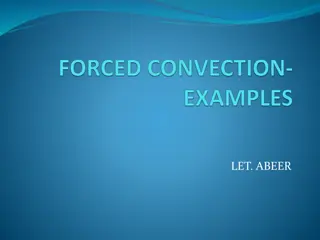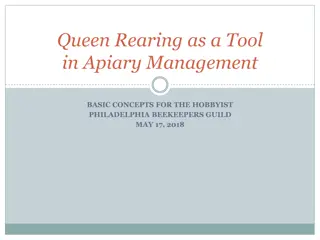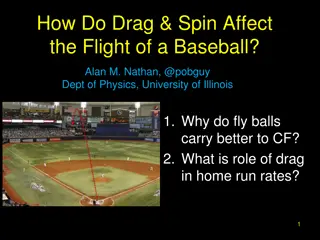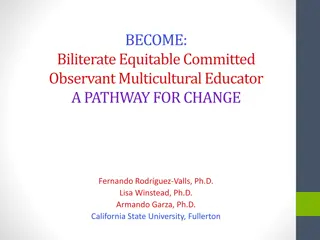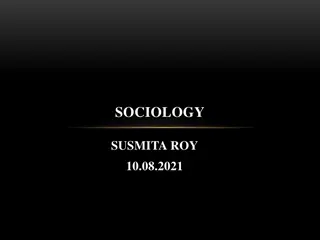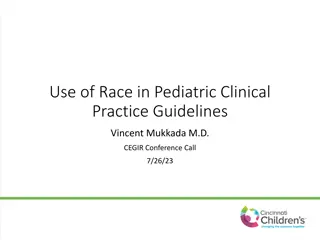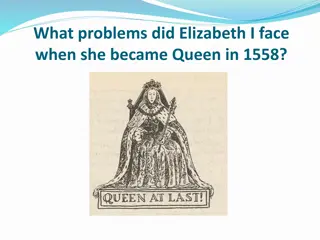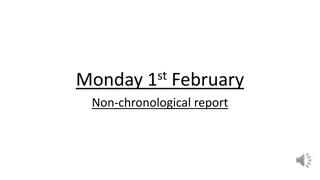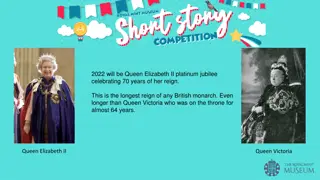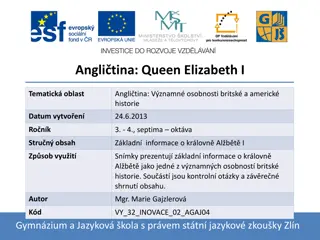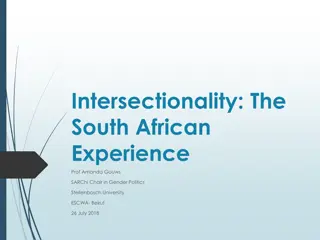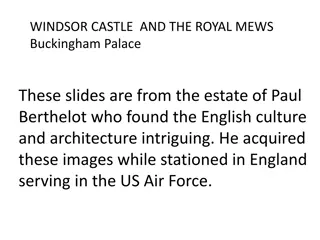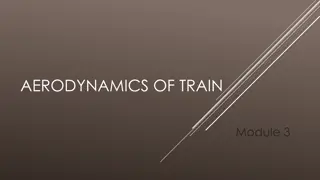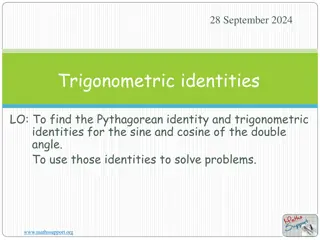Linguistic Analysis of Drag Queen Identities on RuPaul's Drag Race
This analysis explores how drag queens construct their identities through language on the reality television show RuPaul's Drag Race. The study delves into linguistic patterns, cultural ideologies, and social meanings utilized by drag queens, highlighting the multi-layered and polyphonous nature of their identities.
Uploaded on Sep 19, 2024 | 3 Views
Download Presentation

Please find below an Image/Link to download the presentation.
The content on the website is provided AS IS for your information and personal use only. It may not be sold, licensed, or shared on other websites without obtaining consent from the author.If you encounter any issues during the download, it is possible that the publisher has removed the file from their server.
You are allowed to download the files provided on this website for personal or commercial use, subject to the condition that they are used lawfully. All files are the property of their respective owners.
The content on the website is provided AS IS for your information and personal use only. It may not be sold, licensed, or shared on other websites without obtaining consent from the author.
E N D
Presentation Transcript
http://blackgaygossip.co m/index.php/tag/rupaul s-drag-race/ Discursive Identity Construction of Drag Queens on RuPaul s Drag Race By Christopher Sean Perrello Syracuse University csperrel@syr.edu
Motivation Language is a primary vehicle by which cultural ideologies circulate, it is a central site of social practice, and it is crucial means for producing sociocultural identities (Bucholtz & Hall, 2004, p. 492). How does this idea apply to drag queen identities as performed on reality television?
Background Ochs (1992) Indexing Gender helps us better understand how identities are created How drag queens use linguistic patterns to create social meanings, social acts and stances
Background (continued) Barrett (1999): African-American drag queens use 5 of 8 characteristics of Lakoff s (1975) Women s Language (WL) Empty adjectives (fierce, fabulous, amazing) Hypercorrect grammar Use of tag questions The use of hedges (well, y know, kinda) Intense use of so
Background (continued) Barrett also finds that AADQs deviate from the last three rules: Super polite forms (women don t use off-color expressions) Women don t tell jokes Women speak in italics Barrett suggests that AADQ identities are polyphonous and are co-constructed
The Data RuPaul s Drag Race Competitive reality show hosted by RuPaul Charles Competitions require fashion design, wig/make-up artistry, runway fashion show, and lip synching Methodology Episode 1, season 2, Gone with the Window Transcribed and analyzed the runway discourse in the episode (including private testimonials)
Findings Various linguistic devices are used to co-construct drag queen identities Empty Adjectives Crude/sexual humor Verbal art Person-referencing practices, including pronouns (by audience members) Drag queen identities are multi-layered (Barrett: polyphonous identities) RuPaul: African American, gay man, drag queen, diva persona
Linguistic Devices Used to Co- construct Drag Queen Identities
Uses of Empty Adjectives By verbalizing empty adjectives, drag queens are using language to fill a room with flare and flamboyancy. Example: Jujubee 39 I feel great. 40 Sickly. 41 Gorgeous. 42 I wasn t going for pretty, I was going for fierce.
Using Crude/Sexual Humor In order to create a connection with the audience, drag queens often use crude or off- color jokes. Example: RuPaul 21 There s nothing dirty about this Sanchez. 36 I wonder what she uses that rod for?
Drag & Verbal Art Verbal art can be described as discourse of which the primary function is poetic (Johnstone, 2008, p.255). Examples: 24 Raven: My runway walk is giving a little hip action. Flip of the hair, working it out giving them sex! 34 Sonique: Southern belle African, Playboy Mansion, all rolled into one.
Person-referencing Practices Example: RuPaul 5 RuPaul: Okay judges. For this week s challenge, inspired by Miss Scarlet O Hara-- The girls had to turn out a breathtaking drag look Using just curtains and some used home furnishings. Are you ready to see what they created? Gentlemen, start your engines and may the best woman win. There s corn hanging from her hand! Yes, Miss Stacy has a little bustle in her hustle. 8 12 67 RuPaul: 105 RuPaul:
Polyphonous Identity Barrett (1999) detailed the complex identities of African American Drag Queens (AADQs) Polyphonous : using speech to create a variety of multi-layered or repertoire of identities Example: RuPaul Male African American Gay Male Drag Queen
Example of Polyphonous Identity Construction 91 RuPaul: Yeah grommets are fabulous. 92 Kathy: Yeah, me too. 93 I don t know what that is, but I agree. 94 RuPaul: ((Mystique enters the runway)) AWWL- 95 RIGHT! 96 Kathy: Okay. 97 It s not just an outfit, it s a lifestyle. 98 RuPaul: Who needs a hybrid when you can have 99 a basket on your head?
Falsetto & Diva Persona The diva persona is created when gay males use falsetto within their intonation levels to convey certain social situations and social meanings. Podesva (2007) argues that the social and linguistic contexts in which a variable is uttered color its social meaning, enabling the variable to participate in the construction of more specific, identity-based meanings (491).
Example: The Diva Persona L = Low Intonation H = High Intonation (falsetto) 1 RuPaul: 2 3 4 5 6 H Okay judges. H L For this week s challenge, inspired by Miss Scarlet O Hara H L The girls had to turn out a breathtaking drag look L H H H Using just curtains and some used home furnishings. L Are you ready to see what they created? L H L H H Gentlemen, start your engines and may the best woman win. H H H
Conclusion Drag queen identities are created through linguistic features Drag queen identities are a co-construction between the queen and her audience Investigating the details of language lends insight into the complexity of drag queen identities
